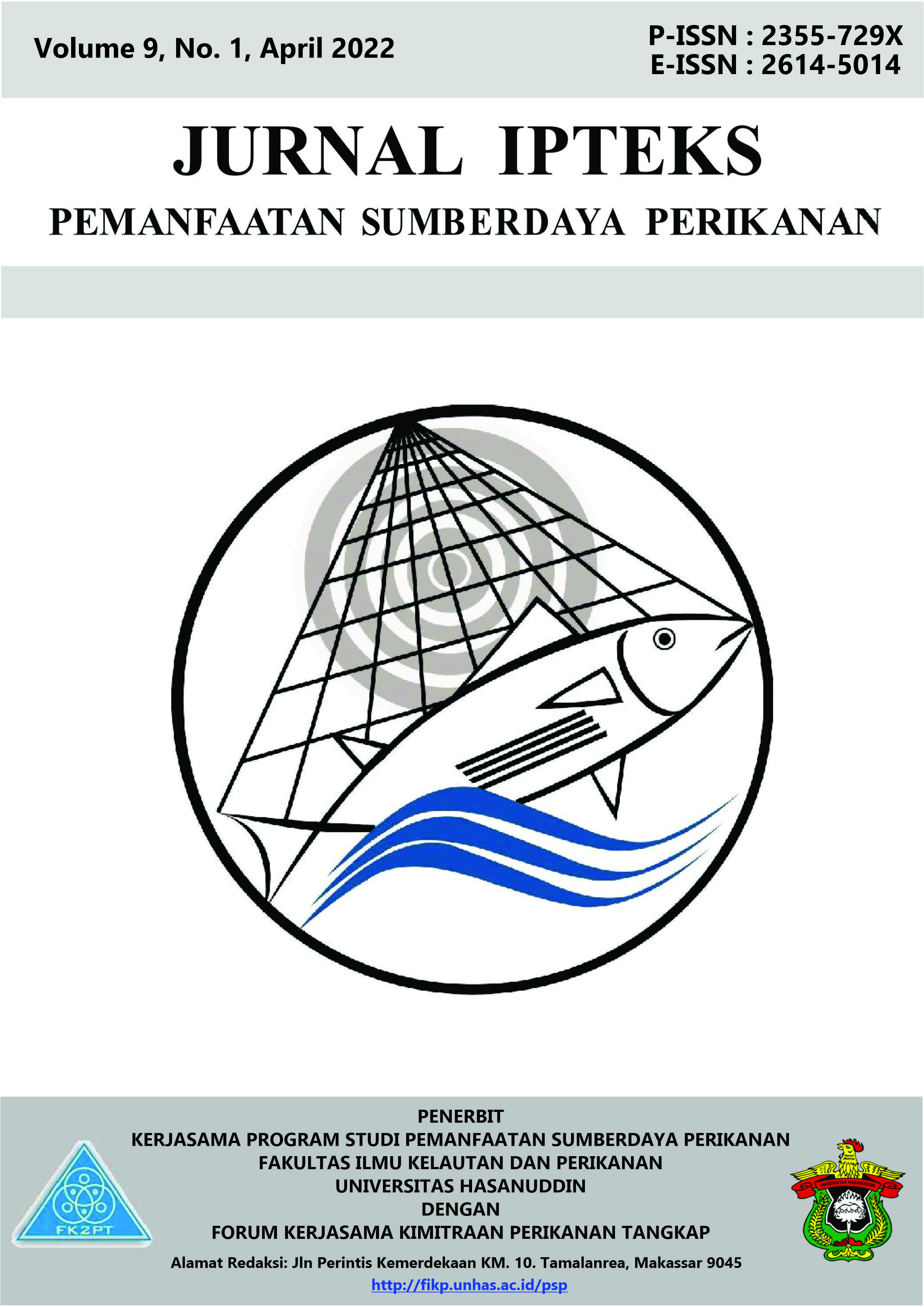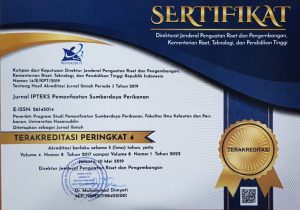Population dynamics of climbing perch fish (Anabas testudineus) in the waters of Tempe Lake, Wajo Regency, South Sulawesi
DOI:
https://doi.org/10.20956/jipsp.v9i1.20062Keywords:
A. testudineus, Exploitation, Growth, Mortality, RecruitmentAbstract
Climbing perch (Anabas testudienus) is one of the inhabitants of Lake Tempe exploited throughout the year, so it is feared that its population has decreased. This study aims to analyze aspects of the dynamics of the climbing perch population, including age group, population growth, mortality, exploitation rate, and yield per recruitment. Data on the total length of fish were collected by measuring all catches of fishermen from October to December 2021. Age groups were analyzed using the Battacharya method, L∞ and K used the Ford and Walford method, M used the Empiris Pauly method, Z, F, and E used the Beverton and Holt method. Data analysis using FISAT-II software and Microsoft Excel. The results showed that the climbing perch in the waters of the Lake Tempe Wajo Regency had a total length range of 6 – 20.8 cm, the highest catch was in the middle-class size of 11.5 – 13.5 cm, and the average length is 13.03±2.15 cm. The population consists of two age groups, the estimated value L∞ = 26.3 cm, K = 0.5 year-1 and t0 = -0.3384 years. The estimated Z, M and F values are 3.41 year-1, 1.22 year-1, and 2.19 year-1, respectively. The exploitation rate is 0.64 year-1, and the actual and optimal Y/R are 0.015gram recruitment-1 and 0.0163 gram recruitment-1, respectively. The conclusion is that climbing perch in the waters of Lake Tempe Wajo Regency require a short time to reach the maximum length, the main cause of population death due to fishing, and the recruitment process is not optimal due to the high rate of exploitation.
References
Akbar, H. 2017. Ekobiologi, Habitat, dan Potensi Budidaya Ikan Climbing perch (Anabas testudineus Bloch) di Indonesia. Universitas Samudra Langsa. Aceh [Indonesia]
Ernawati,Y., Kamal,M.M. & Pellokila,N.A.Y. 2009. Biologi Reproduksi Ikan Climbing perch (Anabas testudineus Bloch, 1792) di Rawa Banjiran Sungai Mahakam , Kalimantan Timur. Jurnal Iktiologi Indonesia, 9 (2): 113-127. [Indonesia]
Felni,A.N., Fauzi,M. & Fajri, N.E. 2020. Populasi Ikan Climbing perch (Anabas testudineus) di Danau Lubuk Siam Desa Lubuk Siam Kecamatan Siak Hulu Provinsi Riau. Universitas Riau. Pekanbaru. [Indonesia]
Maritime Affairs and Fisheries 2010. Kajian Stok Sumberdaya Perikanan di Perairan Danau Tempe Sulawesi Selatan. Balai Riset Perikanan Perairan Umum. [Indonesia]
Mallawa, A, Amir, F. & Farida, G.S. 2017. Kajian Kondisi Stok Ikan Cakalang (Katsuwonus pelamis) di Perairan Teluk Bone Sulawesi Selatan. Jurnal IPTEKS PSP, 4 (7) : 1-7. [Indonesia]
Maurya,A.K., Radhakrishnan,K.V. & Kumar,R. 2020. Population Characteristic and Level of Exploitation of Anabas testudineus (Bloch, 1792) in Rudrasagar Lake, A Ramsar Site in North-estern India. Indian Journal of Geo Marine Science, 49 (2): 298-302.
Mu’awanah,R. 2021. Dinamika Populasi Ikan Climbing perch (Anabas testudienus) yang Tertangkap pada Lalangit, Banjur, dan Tempirai di Perairan Rawa Desa Telok Selong Kabupaten Banjar. Universitas Lambung Mangkurat. Banjarbaru. [Indonesia]
Mustafa,M.G. & Graaf,G.D. 2008. Population Parameters of Important Species in Inland Fisheries of Bangladesh. Asian Fisheries Science. Bangladesh: The WorldFish Center, 5 (1): 19-23.
Mustakim,M., Sunarno,M.T.D., Affandi,R. & Kamal,M.M. 2009. Pertumbuhan Ikan Climbing perch (Anabas testudineus Bloch) di Berbagai Habitat di Lingkungan Danau Melintang Kalimantan Timur. Journal Lit. Perikanan,15 (2): 113-121. [Indonesia]
Mustakim,M., Anggoro,S., Purwanti,F. & Haeruddin. 2018. Population Dynamic of the Climbing Perch Anabas testudineus in the Samyang Lake, East Kalimantan Province, Indonesia. AACL Bioflux, 11 (4): 1038-1046.
Nurdawati,S., Fahmi,Z. & Supriyadi,F. 2019. Parameter Populasi Ikan Climbing perch (Anabas testudineus (BLOCH,1792)) di Ekosistem Paparan Banjir Sungai Musi, Lubuk Lampam. Jurnal Ilmu-Ilmu Hayati, 18 (1): 25-35. [Indonesia]
Putri,D.A., Putra,R.M. & Eddiwan. 2019. Aspek Biologi Reproduksi Ikan Climbing perch (Anabas testudineus Bloch) di Rawa Gambut Desa Pelalawan Kabupaten Pelalawan Provinsi Riau. Universitas Riau. Pekanbaru. [Indonesia]
Situmorang,D., Putra,R.M. & Efizon,D. 2014. Study on Morphometric, Meristic and Growth Patterns of Anabas testudineus in Channel of Oil Palm Plantation Left Tapung River Bencah Kelubi Village Tapung Kiri Subdistrict Riau Province. Universitas Riau. Pekanbaru. [Indonesia]
Sparre,P. & Venema,S.C. 1999. Introduksi Pengkajian Stok Ikan Tropis. Buku 1: Manual. Pusat Penelitian dan Pengembangan Perikanan, penerjemah. Pusat Penelitian dan Pengembangan Perikanan. Jakarta. [Indonesia]
Utomo,A.D. & Wijaya,D. 2008. Dynamic of Fish Production from Lubuk Lampam Floodplain. In: Fisheries Ecology & Management of Lubuk Lampam Floofplain Musi River. Institute for Inland Waters Fisheries. Sumatera Selatan. [Indonesia]
Downloads
Published
How to Cite
Issue
Section
License
Copyright (c) 2022 Jurnal IPTEKS Pemanfaatan Sumberdaya Perikanan

This work is licensed under a Creative Commons Attribution 4.0 International License.














